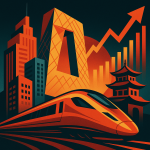“`html
Key Points
- National-scale momentum: Flagship demos like Huawei (Huáwèi 华为) Ascend (Shēngténg 昇腾) 384 super-node hit 300 PFLOPS, and the national computing-power platform is evolving into an early “national-level computing ‘brain’”.
- Huge base capacity: China now has about 10.85 million racks, aggregate storage > 1,680 EB, and reported intelligent compute ≈ 788 EFLOPS (operators also cite examples like Geely’s ~102 EFLOPS center and Qingyang’s 31,000 racks cluster).
- Tangible industry ROI and productivity gains: Every ¥1 RMB invested in compute can generate ¥3–¥4 RMB of GDP; examples include Xishan mine production > 60% higher, Leapmotor (Língpǎo Qìchē 零跑汽车) cutting product cycles from 60 → 24 months, and Guangdong’s AI imaging reading at the throughput of ~150 radiologists/hour.
- Where to focus next: Prioritize interconnection and interoperability (build a compute internet), standards and open interconnects, and architecture planning around latency tiers—1 ms / 5 ms / 20 ms—and breakthroughs for ultra-large clusters (100k+ cards) and end-to-end compute‑network systems.

computing power is the single most important infrastructure trend shaping China’s digital economy today.
Overview
At the 2025 World Artificial Intelligence Conference, Huawei (Huáwèi 华为) publicly demonstrated a live Ascend (Shēngténg 昇腾) 384 super-node system whose total compute reached 300 PFLOPS.
At the 2025 China Computing Power Conference, the national computing-power platform was shown to be fully interconnected—an early form of a national-level computing “brain.”
New versions of products such as DeepSeek are being adapted to next-generation domestically produced chips.
In short, computing power is a hot topic right now.
The State Council recently issued an opinion on deepening the implementation of the “AI+” action, putting forward a series of deployments for computing-power construction.
In the digital-economy era, computing power has become as fundamental as water and electricity.
What is China’s current computing-power profile, and where should future efforts concentrate?

Resume Captain
Your AI Career Toolkit:
- AI Resume Optimization
- Custom Cover Letters
- LinkedIn Profile Boost
- Interview Question Prep
- Salary Negotiation Agent

Foundations Are Being Reinforced
“Scaling up” has become a recurring theme for local computing centers this year:
-
In Wuhan Future Science City, China Telecom (Zhōngguó Diànxìn 中国电信) expanded its Central Intelligent Computing Center by 300 intelligent servers, bringing the center’s compute beyond 2,000 PFLOPS.
-
At the “East Data West Computing” (Dōng Shù Xī Suàn 东数西算) hub in Qingyang, Gansu, the data-center cluster reached 31,000 racks, serving the compute needs of regions including Beijing–Tianjin–Hebei, the Yangtze River Delta, and the Guangdong–Hong Kong–Macao Greater Bay Area.
China is in a critical acceleration phase for the digital economy.
According to Wei Liang (Wèi Liàng 魏亮), vice president of the China Academy of Information and Communications Technology (CAICT, Zhōngguó Xìnxī Tōngxìn Yánjiūyuàn 中国信息通信研究院), the country’s computing industry is advancing on two fronts: structural optimization of compute resources and rapid technical innovation.
Key national-level figures (as of end‑June):
-
Operational standard racks in computing centers: about 10.85 million racks (≈10,850,000 racks).
-
Total compute capacity ranks second globally.
-
Planned construction of more than 250 backbone “East Data West Computing” fiber routes.
-
Aggregate storage capacity exceeding 1,680 EB (exabytes).
Compute is typically categorized as supercomputing, general-purpose, and intelligent (AI) compute.
Intelligent compute underpins AI model iteration; driven by the AI wave, China’s intelligent-compute capacity has reportedly reached 788 EFLOPS (exaflops).
The pattern “AI-dominant, diversified-coordination” is increasingly evident.
Technological innovations keep emerging.
ZTE (Zhōngxìng Tōngxùn 中兴通讯) released an intelligent super-node system featuring a self-developed “Lingyun” AI switching chip and an open high-speed interconnect architecture that breaks hardware silos—allowing domestic GPUs to be assembled modularly and operate in large-scale, high-speed collaboration.
Breakthroughs across chips, software, and intelligent-compute centers are turning domestic compute from merely “available” to genuinely “usable.”
Notably, national-level coordination of compute resources is advancing steadily.
In Hangzhou, Zhejiang, a “1 ms all‑optical intelligent‑compute private network” lets Leapmotor (Língpǎo Qìchē 零跑汽车) schedule compute efficiently.
A Leapmotor engineer noted that with compute–network collaboration, their manufacturing cycle shortened from 60 months to 24 months.
China’s compute-resource layout is becoming more optimized, and a unified, tiered national compute network—hub nodes, regional centers, and local edge layers—is taking shape.
The 2025 Development Report on Compute Capacity shows preliminary formation of:
-
1 ms-latency metropolitan compute networks,
-
5 ms regional compute networks,
-
20 ms cross‑national hub-node compute networks.

Penetration Is Deepening Across Industries
At the Malan mine run by Xishan Coal & Electricity (Xīshān Méidiàn 西山煤电), part of Shanxi Coking Coal (Shānxī Jiāoméi 山西焦煤), the production dispatch center operates remotely: with a single push, a coal-cutting machine hundreds of meters away begins work.
“Compute supports our intelligent upgrade; each shift’s output can be over 60% higher than traditional mining,” a site manager said.
Institutions estimate that for every ¥1 RMB ($0.14 USD) invested in computing power, ¥3–¥4 RMB ($0.42–$0.56 USD) of GDP is generated.
Computing power is restructuring how industries operate and innovate, unlocking the value of data as a strategic factor and driving digital‑intelligent transformation across R&D, production, operations, and maintenance.
At Geely StarRui Intelligent Compute Center (Jílì Xīngruì 智算中心 吉利星睿智算中心), giant screens show requests and real‑time data from regions across the country.
The center’s compute—on the order of 1.02 × 10^20 FLOPS per second (102 EFLOPS in shorthand used by the operator)—supports millions of connected vehicles with real‑time intelligent computation.
“Operating the intelligent compute center has ushered Geely (Jílì Qìchē 吉利汽车) into a new era of AI-driven carmaking,” said Chen Yong (Chén Yǒng 陈勇), chief AI scientist at Geely Research Institute, noting that training driver‑assist models on the platform can cut development cycles by more than six months.
From smart cockpits and driver assistance to vehicle design and factory production, compute is becoming a new engine for the auto industry.
Healthcare is another major area for compute enablement.
Domestic medical data is growing at a compound annual rate of roughly 36%, and demand for compute‑heavy AI solutions is surging.
Guangdong’s Health Commission released “Yue Yi Zhi Ying” (粤医智影), a medical‑imaging AI system that, supported by strong compute and optimized algorithms, can read as many images per hour as 150 radiologists in a top-tier hospital working a full day.
Tianjin Medical University General Hospital deployed a DeepSeek intelligent compute appliance to provide customized compute services for elderly-care and chronic-disease assessment, automated AI exam reports, and other core scenarios—illustrating how compute is reshaping healthcare ecosystems.
According to the Ministry of Industry and Information Technology, intelligent compute is already widely applied in large generative models, embodied intelligence, smart cities, and industrial manufacturing.
Compute‑application competitions have produced more than 23,000 innovative compute projects, with scaled replication in industry, finance, healthcare, and energy.
Xiong Jijun (Xióng Jìjūn 熊继军), vice minister of the Ministry of Industry and Information Technology, said the next steps include deepening a “Compute-Strengthening” challenge program focused on computing, storage, and networking—accelerating adoption of new technologies and products—and advancing compute‑enabled industry applications with targeted actions for education, healthcare, energy, and other priority sectors.

Find Top Talent on China's Leading Networks
- Post Across China's Job Sites from $299 / role, or
- Hire Our Recruiting Pros from $799 / role
- Qualified Candidate Bundles
- Lower Hiring Costs by 80%+
- Expert Team Since 2014
Your First Job Post

Where Should Future Efforts Focus?
China’s compute industry is entering a stage of higher‑quality, larger‑scale development, but challenges remain—misalignment between supply and demand, and gaps in key technologies.
Experts call for optimized compute layouts, stronger collaborative innovation, and continued improvement of end‑to‑end compute‑network supply capabilities.
Forecasts suggest that by 2035 AI could contribute more than ¥11万亿元 to China’s GDP—¥11,000,000,000,000 RMB (about $1.53 trillion USD using an exchange rate of ¥7.20 = $1.00).
Such growth could drive a tenfold to hundredfold increase in compute demand.
Balancing and steadily expanding compute supply will be critical.
Shan Zhiguang (Dān Zhìguǎng 单志广), director of the Informationization and Industry Development Department at the National Information Center, said intelligent‑compute centers should be the top priority in buildouts.
He argued that centers must be designed with advanced system architectures and treat compute as infrastructure—delivering technology rollout and applications across the full stack from facilities to hardware.
Xiong Jijun added that authorities will guide orderly construction of compute facilities, improve the quality of compute resources, refine policy frameworks for compute layout, and steer regions toward rational siting of intelligent compute facilities.
Interconnection of compute resources is another key driver of efficiency.
The May release of the “Compute Interconnection Action Plan” set a target that by 2028 China should achieve standardized nationwide public compute interconnection—progressively forming a compute internet with intelligent sensing, real‑time discovery, and on‑demand access.
“To accelerate and upgrade the compute industry, China must deepen integrated compute‑network construction and strengthen coordinated, dynamic optimization of compute resources,” Wei Liang (Wèi Liàng 魏亮) recommended.
He suggested building unified interconnection standards for compute—standardizing resource sensing, task and data flows, and application‑architecture adaptation—to form a compute internet and a unified market for compute services.
End‑to‑end innovation across the whole chain is essential for high‑quality development.
Li Huidi (Lǐ Huìdí 李慧镝), deputy general manager of China Mobile (Zhōngguó Yídòng 中国移动), recommended concentrating on original innovation: target breakthroughs in ultra‑large intelligent compute clusters (100k+ cards), distributed inference, and hard problems such as memory–compute integration, quantum computing, and photonic computing.
He also urged proactive participation in domestic and international standards bodies and open‑source communities to export a “China solution” for compute networks and build a more resilient, innovative technology ecosystem.

ExpatInvest China
Grow Your RMB in China:
- Invest Your RMB Locally
- Buy & Sell Online in CN¥
- No Lock-In Periods
- English Service & Data
- Start with Only ¥1,000

- Optimized Compute Layouts: Guidance for orderly construction and rational siting of intelligent compute facilities.
- Stronger Collaborative Innovation: Addressing misalignment between supply and demand and technology gaps.
- Improved End-to-End Compute-Network Supply: Deepening integrated construction and dynamic optimization of resources.
- Standardized Public Compute Interconnection: Target by 2028 to form a “compute internet” with intelligent sensing and on-demand access.
- Building Unified Interconnection Standards: For resource sensing, task/data flows, and application adaptation.
- Original Innovation Breakthroughs: Focusing on ultra-large intelligent compute clusters (100k+ cards), distributed inference, and hard problems like memory-compute integration.
- Proactive Participation in Standards Bodies: Both domestic and international, to export “China solutions” and build resilient ecosystems.
Quick Takeaways for Investors, Founders, and Engineers
-
Build for scale: national plans and center expansions make large-scale deployments an investable theme.
-
Focus on interoperability: ZTE’s Lingyun approach highlights the value of open interconnects that break hardware silos.
-
Industry-first wins: manufacturing and healthcare use-cases show compute’s ROI and adoption pathways.
-
Standards & exports: participating in standards and open-source communities is a strategic play for tech firms aiming for global resilience.
-
Latency matters: 1 ms to 20 ms tiers imply edge-to-cloud architectures will dominate solution design for real-time demands.

Linking & Content Opportunities
-
Internal: link to product pages for AI appliances, cloud‑edge solutions, and compute‑network orchestration case studies.
-
External: link to CAICT reports and the State Council document to validate policy context and numbers.
-
Thought leadership: publish whitepapers on compute economics (RMB-to-GDP multipliers) and case studies like Leapmotor (Língpǎo Qìchē 零跑汽车) and Geely (Jílì Qìchē 吉利汽车).

Conclusion
The path to national-scale computing power is underway and will reshape industries, supply chains, and innovation models.
Focused investments in compute centers, interconnection standards, and end-to-end system architectures are the highest-leverage moves for the next five to ten years.
For investors, founders, and engineers building in China, this is a strategic inflection point—plan around latency tiers, interoperability, and industry-specific ROI to capture the next wave of value unlocked by computing power.

References
“`


![China's STAR Market Chip Gear Makers Ride AI Wave: Q1 Revenue Up, R&D Soars [FreshFromChina]](https://freshfromchina.com/wp-content/uploads/2025/05/Chinas-STAR-Market-Chip-Gear-Makers-Ride-AI-Wave-Q1-Revenue-Up-RD-Soars___FreshFromChina-150x150.png)

